Liverwort is a common weed problem in production nurseries and greenhouses. This article has been written to help growers identify liverwort, understand its biology, and inform them of ways this weed can be managed in their operation.
Species Description
Order
Marchantiales
Family
Marchantiaceae
Species
Marchantia polymorpha L.
Other Common Names
Common liverwort, umbrella liverwort
Habitat
In ornamental plant production, liverworts are commonly found growing in cool, moist areas. This may include around container-grown ornamental plants (typically those that are overhead irrigated), in greenhouses, propagation and nursery ground cloth areas, and in any other poorly drained or moist areas (Figure 1). Liverworts typically favor nutrient-rich areas like potting media (Altland n.d.).
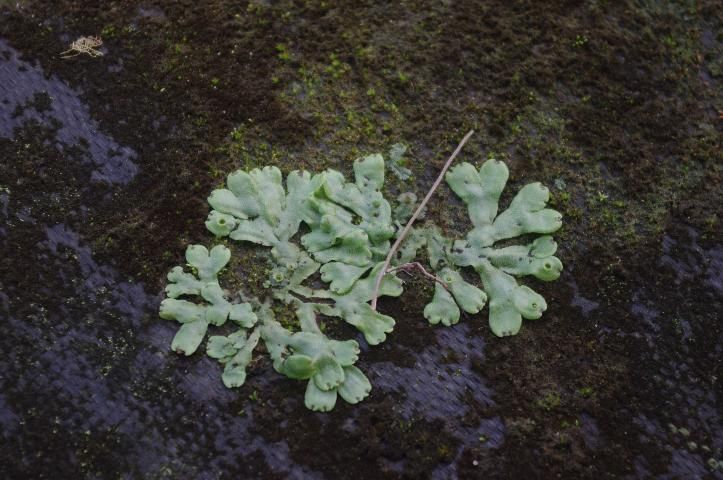
Credit: Annette Chandler, UF/IFAS
Distribution
Occurs in temperate and tropical regions worldwide in a variety of moist, sunny-to-shady habitats. Commonly grows on damp, recently burned soils. The moist, nutrient-rich conditions found in many nurseries and greenhouses are favorable for liverwort growth.
Growth Habit
Dense, green, prostrate or low-growing mats that cover the soil or container media surface. As the liverwort mat forms, it becomes highly competitive with the crop for water and nutrients. Thick mats of liverworts may prevent irrigation and/or fertilizer applications from reaching crop roots, and, when dried, can actually repel water (Neal and Derr 2005).
Foliage
Liverworts do not have true leaves or stems, but have undifferentiated bodies, called thalli (singular thallus), which are glossy green, flattened, irregularly branched, and overlapping (Figure 2). Thalli have dorsiventral symmetry, meaning the upper and lower surfaces are different. The upper surface is photosynthetic and, on mature thalli, bears cup-shaped non-sexual reproductive structures (gemmae), as well as erect, stalked, umbrella-like sexual reproductive organs (gametophores). Thalli contain oil bodies, which may function in UV protection, cold resistance, and herbivore deterrence (He et al. 2013).
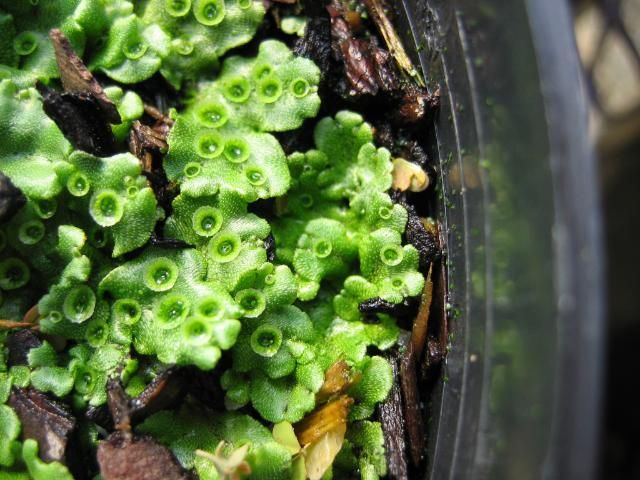
Credit: Chris Marble
Roots
Although liverworts do not have true roots (containing vascular tissues called xylem and phloem), they have unicellular hair-like structures called rhizoids, which grow from the underside of the thallus (Figure 3). Rhizoids anchor the liverwort to the surface it is growing on and help to absorb, conduct, and retain water through capillary action.
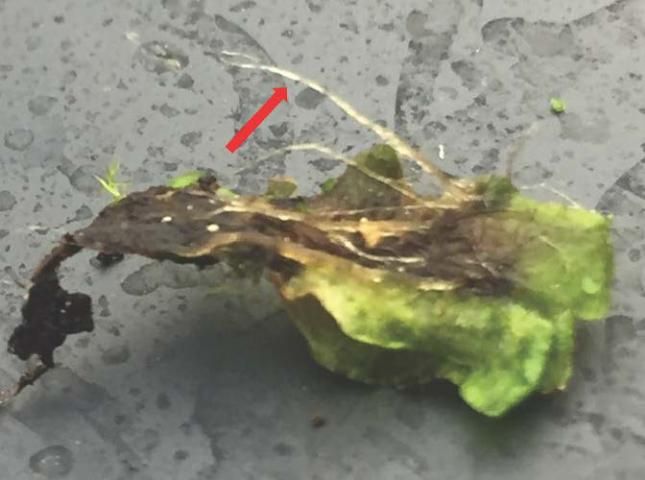
Credit: Chris Marble
Reproductive Structures
Liverworts are able to spread rapidly because they reproduce both sexually and asexually. In sexual reproduction, stalked, umbrella-like male and female reproductive structures are borne on separate thalli. The male reproductive organs (antheridia), which produce the sperm, are located on the upper surface of a flattened disc atop a narrow stalk (antheridiophore) (Figure 4). The female reproductive structures (archeogoniophores) are also stalked, but the upper portion has narrow lobes bending downward along its margins, and the reproductive organs (archegonia), which produce the eggs, are located on the underside of those lobes (Figure 5). Sperm cells produced by the antheridia travel via water (typically from rain or irrigation splashing on the upper surface of the antheridiophore) to fertilize the eggs on the undersides of the archeogoniophore. Spores then develop and, once mature, are dispersed by wind or water and will germinate on a moist substrate under suitable growing conditions. In asexual reproduction, vegetative propagules called gemmae are produced inside circular gemmae cups (Figure 6). Gemmae are spread by irrigation or rainfall splashing into the gemmae cups (Shimamura 2015). When hand-weeding pots, it is critical that all liverwort plant tissue be removed from the pots to prevent regrowth. Even then, tiny spores or gemmae may be present on the soil surface and will result in regrowth.
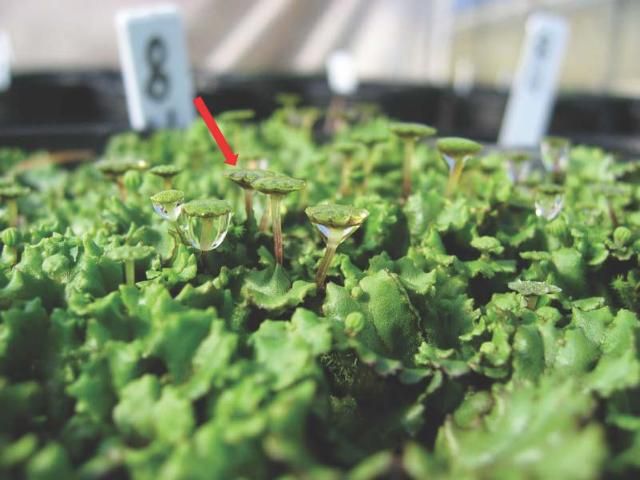
Credit: Chris Marble
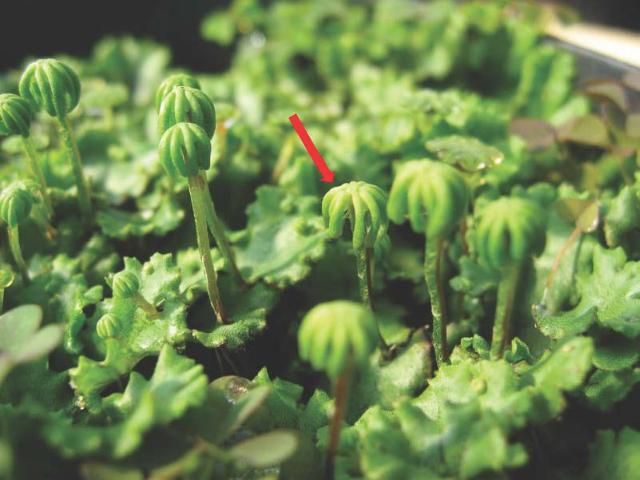
Credit: Chris Marble

Credit: Chris Marble
Similar Species
There are 6,000 to 9,000 species of liverworts, with Marchantia polymorpha being the most common species found in nursery production. Liverworts may appear similar to some mosses and other non-vascular plants, but can be distinguished by their reproductive structures, unicellular rhizoids, and distinctive growth habit. Another liverwort species, Lunularia cruciata, or crescent cup liverwort, has been observed growing in nurseries in other states, but reports indicate that it is easier to manage than Marchantia polymorpha (Altland n.d.). As its common name suggests, Lunularia cruciata can be recognized by its crescent-shaped gemmae cups, while the gemmae cup of Marchantia polymorpha is circular in outline.
Plant Biology
Liverworts are considered the oldest lineage of terrestrial land plants. In Florida, they can grow year-round, especially in greenhouses and other climate-controlled production areas that remain relatively cool or are shaded. As indicated, they are found primarily in areas that stay moist throughout the year, are humid, and are high in nutritional content. Liverworts are not usually found in areas that remain dry for extended times because water is required for their reproduction.
Management
Cultural and Physical Control
Liverwort management requires an integrated approach and cannot be controlled effectively with herbicides alone. Avoid introducing infested stock. Sanitation in the nursery or greenhouse environment is critical. Sanitize greenhouse surfaces, pots, and tools with labeled disinfectants (quaternary ammonium, peroxides, etc.). Avoiding over-irrigation, improving drainage (both in containers and in walkways, floors, greenhouses, etc.), increasing airflow, and switching to micro or drip irrigation systems where feasible can help reduce liverwort infestations. Sub-irrigation systems may also reduce liverwort occurrence (Dumroese et al. 2006, Schmal et al. 2001, Svenson 1998). Mulching with large-particle, porous materials like pine bark or hazelnut shells can also decrease liverwort cover (Svenson 1998). Soil-incorporated rather than top-dressed fertilizer may also further decrease liverwort growth (Altland n.d.). Do not over-fertilize, because high nitrogen and phosphorous levels may increase liverwort growth.
Chemical Control
Preemergence Herbicides
Flumioxazin (Broadstar and SureGuard) are labeled for liverwort control. Broadstar is a granular formulation and can be applied over the top of many woody nursery crops. SureGuard is a water-dispersible granule (WDG) formulation that must be sprayed as a directed application, avoiding crop foliage. Thus, it is most useful in larger containers, and especially with leafless deciduous trees or on nursery floors. Neither product can be used inside a greenhouse (SureGuard can be applied if no plants are present; growers should wait 24 hours and water in SureGuard before bringing plants inside a treated greenhouse). Research trials in Oregon and Alabama (Altland n.d., Newby 2006) have demonstrated that herbicides containing oxyfluorfen (OH2, Regal O-O, Rout, etc.) or oxadiazon (Ronstar) may reduce liverwort coverage on container media when applied preemergence. All three of these herbicides (flumioxazin, oxyfluorfen, and oxadiazon) are Group 14 herbicides known as "protox" or protoporphyrinogen oxidase (PPO) inhibitors. Preemergence herbicides containing these active ingredients may provide some level of suppression depending upon nursery conditions, but further research is needed. Preemergence herbicides are less effective if cultural conditions favoring liverwort growth are not corrected. Herbicides showing some efficacy on liverwort are summarized in Table 1.
Postemergence Herbicides
Glyphosate offers little to no control. In addition to preemergence use, flumioxazin (SureGuard, Broadstar) can provide some postemergence control of liverwort. However, control is usually much greater and faster with SureGuard. Acetic acid (vinegar) products have also provided liverwort control in research trials (Altland n.d.). When considering acetic acid or other products, only those labeled for use as pesticides in nurseries should be applied. Other herbicides that have shown efficacy on liverwort include mostly non-systemic contact products including diquat (Reward), ammonium nonanoate (Axxe), sodium carbonate peroxyhydrate (TerraCyte), and pelargonic acid (Scythe). All of these herbicides can cause significant damage to ornamentals when applied to foliage or other green tissues. Therefore, be sure sprays are directed away from the plant. Dimethenamid-p (Tower) is a preemergence herbicide labeled for use over the top of many ornamental plants. However, research has shown that it may provide some postemergence control of liverwort when applied at 32 fl. oz. per acre, but Tower herbicide is slow to work and results may vary. Postemergence herbicides that provide some control of liverwort, and the areas in which they can be applied, are summarized in Table 2. Additional information on other active ingredients, crop safety, and research summaries are available in the IR-4 ornamental horticulture database available at http://ir4.rutgers.edu/Ornamental/Ornamentals.cfm.
References
Altland, J.A. n.d. Marchantia polymorpha liverwort page. Accessed: March 27, 2017. https://horticulture.oregonstate.edu/weed/liverwort.
Dumroese, R.K., J.R. Pinto, D.F. Jacobs, A.S. Davis, and B. Horiuchi. 2011. "Subirrigation reduces water use, nitrogen loss, and moss growth in a container nursery." Native Plant J. 7(3):253–261.
He, X., Y. Sun, and R.-L. Zhu. 2013. "The oil bodies in liverworts: unique and important organelles in land plants." Critical Reviews in Plant Sciences. 32(5):293–302.
Neal, J.C. and D.F. Derr. 2005. "Weeds of container nurseries in the United States." North Carolina Assoc. of Nurserymen, Inc. Raleigh, NC. 16 p.
Newby, A.F. 2006. "Liverwort control in container-grown nursery crops." Thesis, Auburn University, Auburn, AL. 80 p.
Schmal, J.L., R.K. Dumroese, A.S. Davis, J.R. Pinto, and D.F. Jacobs. 2011. "Subirrigation for production of native plants in nurseries – concepts, current knowledge, and implementation." Native Plants. 12(2):81–93.
Shimamura, M. 2015. Marchantia polymorpha: "Taxonomy, phylogeny, and morphology of a model system." Plant Cell Physio. Accessed: March 10, 2022. https://academic.oup.com/pcp/article/57/2/230/2460945.
Svenson, S.E. 1998. "Suppression of liverwort growth in containers using irrigation, mulches, fertilizers, and herbicides." HortScience. 33:3 S231.
This table lists registered pesticides that should be integrated with other pest management methods. Contact your local UF/IFAS Extension office for additional information (https://ifas.ufl.edu). Contact: Weed Specialist (marblesc@ufl.edu). Table 1. Protox1 inhibiting preemergence herbicides labeled for use in ornamental plant production.
This table lists registered pesticides that should be integrated with other pest management methods. Contact your local UF/IFAS Extension office for additional information (https://ifas.ufl.edu). Contact: Weed Specialist (marblesc@ufl.edu). Table 2. Herbicides labeled for use in ornamental plant production that provide postemergence liverwort control1.